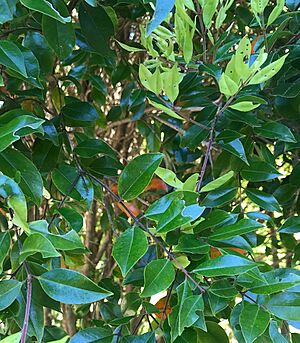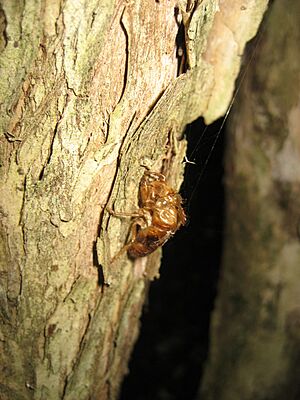Bartlett's rātā facts for kids
Quick facts for kids Bartlett's rātā |
|
|---|---|
 |
|
| Bartlett's rātā | |
| Conservation status | |
| Scientific classification | |
| Genus: |
Metrosideros
|
| Species: |
bartlettii
|
The Bartlett's rātā (scientific name: Metrosideros bartlettii) is a very special tree from New Zealand. It's also known as Cape Reinga white rātā or rātā moehau in Māori. This tree is super rare and stands out because it has white flowers, which is unusual for its family of trees that usually have red flowers.
You can only find Bartlett's rātā in the very far north of New Zealand's North Island. It grows in three small areas of thick native forest near Spirits Bay. These forests, called Radar Bush, Kohuronaki Bush, and Unuwhao Bush, managed to survive big fires. Sadly, only 13 adult trees are left in the wild today. Many of these are not doing well. Scientists think this tree has always lived only in this small area.
What Does It Look Like?
A schoolteacher from Auckland, named John Bartlett, discovered this tree in 1975. He found it growing in Radar Bush. It took almost ten years to collect its flowers so scientists could properly describe it.
Bartlett's rātā can grow up to 30 meters (about 100 feet) tall. It often starts its life growing on other trees like taraire, puriri, rewarewa, or tree ferns. Sometimes, it grows on rocky cliffs or outcrops.
The tree has white flowers that look like a fluffy mass of stamens. These flowers appear in November or December. Its seeds are ready in March or April. The trunk can be as wide as 1.5 meters (about 5 feet).
Bartlett's rātā looks a bit like the northern rātā. But you can tell them apart by the white flowers and the leaves. Bartlett's rātā leaves come to a point, while northern rātā leaves have a notch at the tip. Another special thing is its white or grayish bark. It peels off easily in soft flakes. This bark might help protect the tree from fire, which is important in an area where forest fires can happen.
Saving the Tree
Even though some Bartlett's rātā trees are grown by people, most of these come from just one original tree. This means there isn't much genetic variety among them. Only 13 adult trees are left in the wild, and most of them are on private land.
Many of these wild trees are far from each other. This makes it hard for pollen to spread, so they don't produce many seeds. Scientists have checked their DNA and found very little genetic difference. This makes the trees weaker against diseases or changes in their environment.
The trees are also in danger from animals eating them. Fires and changes in how landowners use their land are also big risks.
The local Māori tribe, Ngāti Kurī, and the Department of Conservation are working hard to help these trees. They have planted 360 new trees in Radar Bush and Kohuronaki Bush. They are also planting more trees in Unuwhao Bush, which is where most of the remaining trees are. They are even starting new planting sites in the Far North. They use seedlings from all three forest areas to make sure they keep as much genetic variety as possible.
Growing Bartlett's Rātā
Bartlett's rātā is quite easy to grow from fresh seeds. It likes sunny spots with good soil that drains water well. You can also grow it from cuttings, but these might take a long time to grow roots.
The plants grown in New Zealand are quite tough. They can handle different conditions. They have even shown that they can survive mild frosts, even though frosts don't happen in their natural home.
See also
 In Spanish: Árbol rata de Bartlett para niños
In Spanish: Árbol rata de Bartlett para niños





